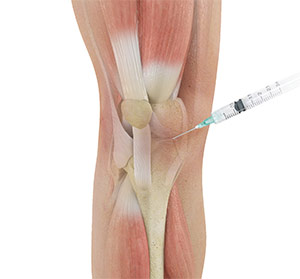Steroid injection for joint pain
 A steroid injection is a minimally invasive procedure that can temporarily relieve pain caused by an inflamed joint. The cause of joint pain (arthritis, injury, degeneration) is not well understood. The procedure has two purposes. First, it can be used as a diagnostic test to see if the pain is actually coming from the joint. Second, it can be used as a treatment to relieve inflammation and pain caused by various conditions.
A steroid injection is a minimally invasive procedure that can temporarily relieve pain caused by an inflamed joint. The cause of joint pain (arthritis, injury, degeneration) is not well understood. The procedure has two purposes. First, it can be used as a diagnostic test to see if the pain is actually coming from the joint. Second, it can be used as a treatment to relieve inflammation and pain caused by various conditions.
What is a steroid joint injection?
A steroid injection includes both a corticosteroid (e.g., triamcinolone, methylprednisolone, dexamethasone) and an anesthetic numbing agent (e.g., lidocaine or bupivacaine). The drugs are delivered to the painful joint, inside the joint capsule.
Corticosteroid injections can reduce inflammation and can be effective when delivered directly into the painful area. The pain relief can last from days to years, allowing your condition to improve with physical therapy and an exercise program.
Injections can be made in the following areas:
- facet joints of the spine
- sacroiliac joint and coccyx
- hip joint
- shoulder, elbow, and hand
- knee, ankle and foot
Who is a candidate?
If you have pain stemming from joint inflammation, then you may benefit from a steroid injection. Typically, a joint injection is recommended for those who do not respond to other conservative treatments, such as oral anti-inflammatory medication, rest or physical therapy.
Steroid joint injections done using ultrasound guidance should NOT be performed on people who have an infection, are pregnant, or have bleeding problems. The injection may slightly elevate blood sugar levels in patients with diabetes. It may also temporarily elevate blood pressure or eye pressure for patients with glaucoma. You should discuss this with your physician.
What are the results?
If the joint that was treated is the source of pain, you may notice pain relief starting two to seven days after the injection. Pain may be relieved for several days to several months, allowing you to participate in physical therapy. If injections were helpful and you experience a later recurrence of pain, the procedure can be repeated. If you don’t experience any pain relief, other treatment options may be available.
What are the risks?
With few risks, steroid joint injections are considered an appropriate nonsurgical treatment for some patients. The potential risks associated with inserting the needle include bleeding, infection, allergic reaction, headache, and nerve damage (rare). Corticosteroid side effects may cause temporary weight gain, water retention, flushing (hot flashes), mood swings or insomnia, and elevated blood sugar levels in diabetics. These effects usually disappear within 7-10 days. Patients who are being treated for chronic conditions (e.g. heart disease, diabetes, rheumatoid arthritis, glaucoma, uncontrolled blood pressure) or those who cannot temporarily discontinue anti-clotting medication should consult their personal physician for a risk assessment.
